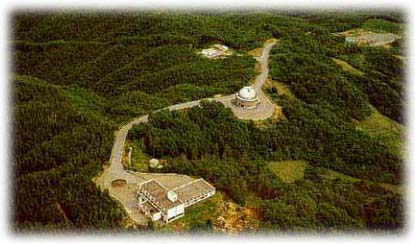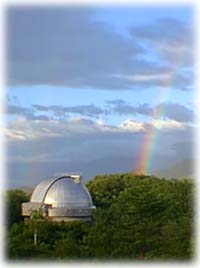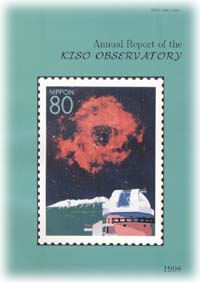Overview

History
Kiso Observatory was founded in 1974 as the fifth branch observatory
of the Tokyo Astronomical Observatory, University of Tokyo,
which is one of the Japanese national universities that belong to
the Ministry of Education, Science and Culture (MESC).
The main objectives of Kiso Observatory stated at the time of
foundation were `observational researches of various astronomical
objects in and outside our Galaxy with the 105 cm Schmidt telescope,
and observation of the night sky light.
' It was also stated that `research facilities of Kiso Observatory
shall be open to visiting astronomers as well as to the staff and
students of the University of Tokyo.'
Ever since, Kiso Observatory has been accepting visiting astronomers
who want to use its research facilities.
On July 1, 1988, Kiso Observatory was reformed as a university
observatory belonging to the Institute of Astronomy, Faculty of
Science, University of Tokyo, when the Tokyo Astronomical
Observatory was removed from the University of Tokyo to be
reorganized as a new institution, the National Astronomical
Observatory of Japan (NAOJ) operated directly by MESC.
Kiso Observatory is open to astronomers in both domestic and
foreign institutions.
This is because the facilities at Kiso are of primary importance
in many fields of astronomy.
The principle of common use of important facilities is encouraged
by MESC, and a limited amount of travel expenses for astronomers
from domestic institutions was granted at the time of the reform.
Reasearch Activities

Researches at Kiso Observatory have been primarily based on the
105cm Schmidt telescope and related facilities installed in 1974,
but continuous efforts have been made to enhance research facilities
and activities. An image data processing system was introduced in 1985,
and large coordinated efforts were devoted to the development of
a software package for interactive astronomical image data processing.
Visiting astronomers who used the image data processing system
increased continuously since 1986.
Photographic imaging was virtually a sole method of observation
for two decades at Kiso since the opening of Kiso Observatory.
However, in need of deeper images to study the distant and faint
objects, the observatory started to develop a CCD camera in 1987.
In 1993, a CCD camera with 1024x1024 pixels was made available to
visiting astronomers.
Furthermore, the development of the 2KCCD camera started in 1993,
and the common use started in 1998. In April 2012, common use observations
using an wide-field mosaic CCD camera (KWFC) with a field of view of
approximately 4 square degrees began, and a large-scale observation program
utilizing KWFC's high survey capability was also implemented.
From fiscal 2014, we have implemented "automatic observation"
using the queue system, which enables more efficient observation.
It is effective for long-term monitoring observations and survey observations
because it automatically executes the observations registered in the queue
according to the weather and observation conditions and can be
monitored remotely from anywhere.
From 2014, we developed the next wide-field CMOS camera "Tomo-e Gozen"
and started full operation in October 2019.
The Tomo-e Gozen camera covers a field-of-view of 20 square degrees
on the sky at once by 84 chips of 35 mm full HD CMOS image sensors.
This is the world’s first astronomical wide-field movie camera,
which can capture images at intervals of 1 seconds or less.
Over 100 nights every year, Tomo-e Gozen carries out movie surveys of
the sky repeatedly in a night.
It is expected that transient events found by Tomo-e Gozen include
many scientifically important phenomena such as supernovae just after
explosions and asteroids with possibility of collision to the Earth.
Committee, Meetings, Publications

Principles related to the use of Kiso Observatory are discussed
in the Kiso Users' Committee. Symposia which are closely
related to the research projects at Kiso include `Schmidt Symposium'
held around July every year.
Report of the Kiso Observatory was published until 1988 as 15 issues
of `Kiso Information Bulletin' (KIB); Vol. 1, No. 1 was
published in June 1979, and the last issue Vol. 2, No. 5 in March 1988.
KIB was succeeded at the time of the reform by a new series
of `the Annual Report of the Kiso Observatory', which is published
once a year.
Although it is a new series of publication, the Annual Report is,
in many respects, a continuation of the Kiso Information Bulletin.
Postal Address
Kiso Observatory,
Institute of Astronomy,
The University of Tokyo
Mitake 10762-30, Kiso-machi, Kiso-gun,
Nagano-ken 397-0101
JAPAN
Telephone number
+81-264-52-3360
Facsimile number
+81-264-52-3361